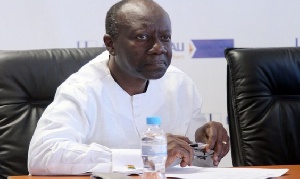 ken Ofori-Atta, Finance Minister
ken Ofori-Atta, Finance Minister
The public debt stock has risen from GH¢122.6 billion in December 2016 to GH¢142.5 billion in December 2017.
The new figure is equivalent to 69.8 percent of the country’s total economic output, measured by gross domestic product (GDP).
The latest statistics on the debt means that some GH¢19.9 billion has been added to the public debt within the past 12 months.
Data released by the Bank of Ghana (BoG) ahead of the bank’s Monetary Policy Committee (MPC) press conference today show that GH¢78.5 billion of the current debt stock was external or foreign debt, while the remaining GH¢66.7 billion was domestic debt — borrowing from the domestic financial market.
However, the December 2017 debt-to-GDP ratio is still within the government’s end of year projection of 71 percent of GDP announced in July last year.
Debt growth
Since 2014, discussions on the economy have centred more on the debt stock after increased borrowing negatively impacted on other fiscal indices.
From GH¢4.9 billion in 2006, the national debt stock rose to GH¢122.6 billion in 2016, as the country tried without success to borrow its way out of debt.
Since then, growth in the public debt in nominal terms (without accounting for inflation) has slowed, albeit inconsistent, and that has resulted in a corresponding decline in the ratio of the debt-to-GDP.
In May 2017, the debt stock was GH¢137.5 billion (67.3 percent of GDP) but rose marginally to GH¢138.9 billion (68.1 percent of GDP) in September.
It then rose to GH¢139 billion (68.1 percent of GDP) in November before ending the year at GH¢142.5 billion (69.8 percent of GDP).
The marginal declines are attributable to the government’s debt management strategy, which hinges on substituting expensive debts with comparatively cheaper debts through a process termed reprofiling.
Debt servicing cost
Notwithstanding the moderation in the nominal debt figures, debt servicing cost still remains a concern to many, including the International Monetary Fund (IMF).
From GH¢393.4 million in 2006, the amount used to repay loans rose to GH¢10.7 billion in 2016 and is now estimated that in 2017 and 2018, GH¢13.3 billion and GH¢14.9 billion respectively, will be used to repay loans, including the interest.
In a paper titled ‘Ghana’s growing public debt and its implications for the economy,’ a fiscal policy think tank, the Institute for Fiscal Policy (IFS), said the “debt service now absorbs a large part of domestic revenue, leaving the country vulnerable to shocks.”
It observed that, “The country has fallen into a debt trap as real interest rates continue to surpass GDP growth rates, which has forced the country to continue committing more of its tax revenue to service debts,” it added.
Experts worried
A Professor of Economics at the Institute of Statistical, Social and Economics Research (ISSER), Prof. Peter Quartey, told the Daily Graphic that the country needed to be cautious in accumulating new debts.
“I thought with all the debt restructuring, reprofiling and all those things, the debt-to-GDP will be coming down but if it is going up, then of course, there should be a cause for concern,” he said in an interview yesterday.
His concerns were similar to those shared by the Resident Representative of the IMF, Ms Natalia Koliadina.
In an email response to questions on the country’s debt position on March 16, Ms Koliadina said current debt numbers required that the country exercise caution in accumulating new debts.
“In order to preserve debt sustainability, the authorities need to limit non-concessional borrowing to finance high priority infrastructure projects, which will add to the economy’s growth potential,” she said.
Impact on Ghana Beyond Aid
Beyond eroding investor confidence, sapping revenue through high debt service cost and causing the cedi to depreciate, Prof. Quartey said a firm growth in the debt stock could threaten President Nana Addo Dankwa Akufo-Addo’s agenda to grow the country beyond aid.
“If the debt is high, then it means that a lot more of our revenue will be used to service debt. That will mean that we will not have enough revenue to finance other expenditures, especially development expenditures,” Prof. Quartey said.
“Mind you, once we pay salaries and wages, make statutory payments and also service debts, what is left is always insignificant in financing development expenditures,” he explained.
That, he said, would leave the country with less revenue to develop and that could compel it to fall back on aid, contrary to what the President had been positing.
Prudent uses
Prof. Quartey also called for prudent utilisation of borrowed funds to help get value for money, advising that new borrowings should be used to fund productive ventures.
“If for instance such money is used to finance a project like Planting for Food and Jobs, then it will show in growth in agriculture,” he said.